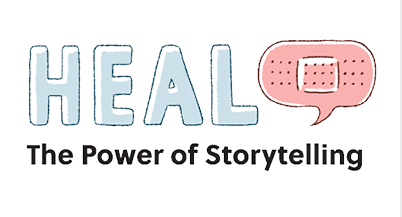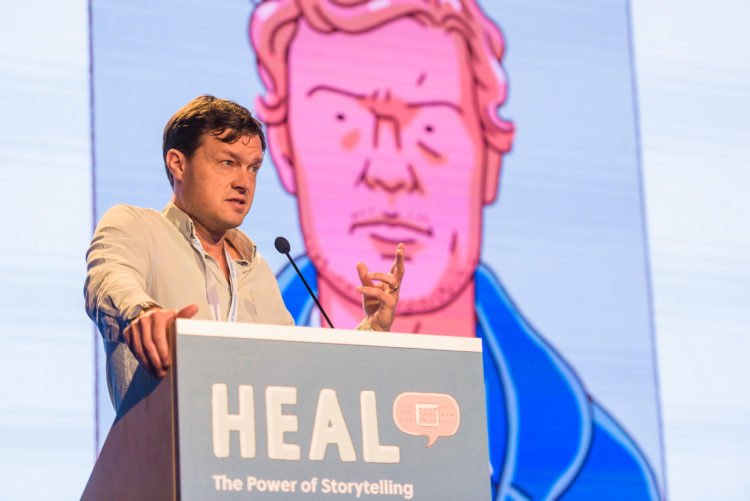We all love a good hero story: Spiderman swooping in to save the day and the girl; Batman brooding towards a better tomorrow; The Avengers joining forces to save the planet. In journalism, we often profile admirable people who have hero-like qualities: leaders who risk all to forge a new business or movement, artists or inventors who create original work, humanitarians who sacrifice themselves on behalf of others. We celebrate the good guys.
But there are some of us who are obsessed with humanity’s dark side.
Evan Ratliff, co-founder of the Longform podcast and author of “The Mastermind: Drugs. Empire. Murder. Betrayal.”, confessed he belongs to that latter camp. In a keynote at The Power of Storytelling conference in Bucharest last month, Ratliff explained his “love” of villains and his belief that their stories offer valuable lessons that deserve our attention.
“I love scammers. I love hackers. I love thieves, arms dealers, people who faked their own death and left their families behind, crooked cops, mercenaries, drugs dealers, arms dealers, assassins,” he said. “Maybe love is too strong a word, but I’m fascinated with these people. I can spend a lot of time thinking about them.”

Which is exactly what he did while researching Paul Le Roux, the anti-hero in "The Mastermind." Le Roux was a reclusive computer programmer turned criminal genius who made a fortune leading one of the biggest criminal organizations in the world. Ratliff took four years to research the story, which was first published as a seven-part series by The Atavist (an online longform magazine he co-founded, recently acquired by the parent company of WordPress). He traveled the globe — from the
Philippines to Vietnam to Israel to Brazil — to find and interview Le Roux’s former associates and try to understand their motivations.
But in his keynote, he also explored his own motivations for pursuing stories some might find off-putting.
“Why am I so fascinated with these people?” he pondered. “Not just in a therapeutic sense for myself, but for you also, as people who tell stories and people who consume stories — why are these people worth your time? What can we learn from the worst people among us?”
For his book research, Ratliff spent hours and hours with characters who were dangerous and seemingly immoral: A highly decorated U.S. military veteran whom Le Roux hired to assassinate an American drug enforcement agent; a mercenary who refused to work with Le Roux and then lost business to him; a former South African police officer who became Le Roux’s hitman. Ratliff suspended judgment during his interviews as he explored how and why they wrapped themselves in lives of crime. And how did the kingpin become one of the most feared crime bosses on the planet?
Le Roux was a South African native with an early talent for programming. He left home at 18, moved to London and made a name for himself in the software industry. In his mid-twenties, he wrote the underlying code for a famous piece of encryption software called TrueCrypt, which was used to secure disk drives and laptops against government intrusion. “Even to this day, the NSA has been unable to break it,” Ratliff said.
But Le Roux never made any money off his invention. So in 2004, he set up a shady business in the Philippines to sell prescription drugs over the internet, working through multiple websites and with a network of American physicians and pharmacies enabling the sales. He raked in a fortune, which he then leveraged into a multi-national criminal conglomerate.
“In the financial world, they would call it diversifying,” Ratliff said. “He diversified into every kind of crime you can think of — drug trafficking at a large scale, he dealt arms of all types in many parts of the world, he had a militia in Somalia, and he had thousands of people working for him.”
By the end of Le Roux’s reign in 2012, he had built a hit list that contained journalists, judges, rivals and people who owed him as little as $1,000.
“I started thinking of Paul as an alternate world version of a modern tech founder – the Mark Zuckerbergs and the Elon Musks of the world,” Ratliff said. “Potentially brilliant either in technology or in business, gifted, nerdy people who had the ability to change the world.
“Those guys had gone down one path — they had built these world-changing companies — and Paul had gone down this other path and built this mirror-image unicorn on the other side of the law. His company, in 2008, was worth more than Facebook.”
Ratliff also was interested in Le Roux’s victims and the federal investigators who pursued him until his arrest in Liberia seven years ago. But his real focus was on the moral compromises people made along the way that landed them deep inside a criminal organization. Besides the difficult and often dangerous reporting, Ratliff acknowledged that he had set himself up with a readership challenge.
“Where's the healing in telling a story like that?” he said. “Aren’t these people just evil? Aren't they psychotic? What's the point of listening to them or even really knowing about them?”
His initial thought was that not every story has to change the world, and it’s hard to predict which stories will resonate with readers. But he came to question whether that was an adequate rationale when profiling people who left a trail of real victims and suffering. After all, this wasn’t just “a fun heist story.”
Over time, Ratliff said, he came to believe that stories about darkness have societal value: “At their best, these kinds of stories are not just about the Paul Le Rouxes of the world — these people who have done these terrible things. They can illuminate the systems that allowed them to flourish.”
Case in point: Paul Le Roux’s story provided insights into the exploitation of the opioid crisis in the U.S., the impact of the wars in Iraq and Afghanistan on soldiers and private contractors, government and business corruption in the Philippines, and failings of the American justice system.
Beyond that, people who commit evil can be a kind of conveyance mechanism to understand morality. “Not just their morality, but also our morality,” Ratliff said. “I don't mean that we're all one step away from becoming an assassin. But the people who have made these aberrant choices can give us a window into understanding motivations, desires, and impulses.”
Even some of worst people in Le Roux’s circle told Ratliff they were grateful he was telling their stories. Most had never spoken about what they had done. Many confessed shame or confusion: How had compromises that seemed small and meaningless in the moment led them to this?
“You can find that path reflected in the world around you,” Ratliff said. “I said I thought Paul was this mirror image of these tech moguls, but by the end, I didn't really think of him that way. I thought of him as existing on the same curve as those people, the Facebooks and Ubers of the world. Granted, his was a much more extreme version of that, but the idea of taking a sort of amoral approach to your business practices in order to fuel the growth of your corporate empire is something we're seeing all around us. Recognizing that is valuable.”
He suggested that the difference between Le Roux’s organization and something like Facebook, if we look at influencing elections or conflicts around the world, is a difference in severity, but not in kind.
“The thought I want to leave you with is this: The unfortunate reality is that our lives are affected by people like this. Sometimes our countries are governed by people like this — people who have followed the siren song of their worst impulses. And I think – not to be too grandiose – that one way we can hope to constrain those people is to recognize them for what they are and try to understand them better than they understand themselves.”



